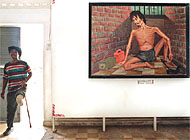Coming to terms with torture through art

To mark the international day in support of the victims of torture the Office of the United Nations High Commissioner for Human Rights is holding an exhibition of works of art by vicitims of torture.
Art therapy has become an important part of rehabilitation schemes.
Forty organisations from 32 countries have donated works to the office’s fund for assisting the victims of torture. The paintings, sculptures, drawings and embroidery come from countries from virtually every region of the world.
“Torture is still very widespread,” says Daniel Prémont, secretary of the fund for victims of torture. “In the 1970s we thought it would only take 10 years to eradicate torture, or at least get a better situation in administrative detention, but unfortunately it’s not really improving.”
He says in that time, the definition of torture has widened: “For the families of people who have disappeared or who have been killed by the state, this is a form of torture. It’s also torture if a woman is raped by agents of a government.”
It was around 30 years ago that doctors began using art therapy for torture victims. Being able to depict what happened to them is often the easiest way to come to terms with the horrors they have experienced.
“Sometimes people cannot speak about what was done to them, especially when you are giving them therapy shortly after they were tortured,” Prémont told swissinfo.
“Rather than letting them express themselves through words or written documents, you can use art therapy. This kind of therapy not only allows victims to show what happened, but they can also express how they feel about the future,” he explained.
“After a few weeks or months, you may see the sun or leaves, or more colour, appearing in their paintings, and this is a good indication that the therapy is working,” he says.
A series of four pictures in the exhibition shows how one man, who was tortured for being an opposition activist in his country, responded to this treatment. Doctors said his pictures showed that he was “able to connect to life again.”
Many of the 150 works on show graphically demonstrate the methods of torture used on the people who produced them, a large proportion of them women and children.
“This exhibition is divided into two or three main themes. But we cannot choose the themes. They have to be selected by the victims themselves. Up to 40 per cent of the artworks deal with what happened to them. This is part of the healing process,” Prémont explains.
“By describing the methods of torture used, it’s also a way for them to demand justice. They want the torturers to be brought to trial,” he adds.
The exhibition of art by victims of torture will be at the Palais Wilson in Geneva until July 6.
by Roy Probert

In compliance with the JTI standards
More: SWI swissinfo.ch certified by the Journalism Trust Initiative
You can find an overview of ongoing debates with our journalists here. Please join us!
If you want to start a conversation about a topic raised in this article or want to report factual errors, email us at english@swissinfo.ch.